Determining FBO multiples
A business valuation veteran looks at what FBOs need to consider
By Michael A. Hodges, President & CEO, Airport Business Solutions
June 2000
A business valuation veteran looks at what FBOs need to consider In this very active period of FBO sales and acquisitions, a common question bantered about within the industry is: "What kind of multiples are being paid?" Unfortunately, the answer is not as simple as the question may appear.
In the fixed base operator (FBO) industry, the comparative factor of choice in determining value is the "multiple of EBITDA." EBITDA is an acronym for "Earnings Before Interest, Taxes, Depreciation and Amortization." This generally reflects the cash flow of the business before the deduction of such debt and accounting issues as a mortgage and depreciation.
In other words, the starting point in negotiations typically begins with an all-cash value, disregarding all existing debts. Buyers are less concerned on the front end whether a business is highly leveraged or owned debt-free. (This typically comes into play later in the negotiations when the terms of the sale are discussed.) Their primary concern is whether the cash flow of the business will cover the financing structure that they propose to put in place.
In the case of an all-cash transaction without financing (few and far between, despite what you may have heard), the owner wants to ensure that the deal will provide a reasonable return on his/her equity.
The reason for providing this background information relates to the fact that often when someone quotes a "multiple," they are unaware of what figure it should actually be (or was) applied to. In the world of valuation, the "multiple" is simply the relationship between EBITDA and the selling price of a business. If a business sells for $6 million and the EBITDA at the time of sale was $1 million, then the multiple is 6.0. (The EBITDA utilized can be previous year-end, trailing 12 months, or even the previous quarter or quarters annualized.)
The derivation of a multiple is just simple, basic math. However, despite the rather straightforward definition of EBITDA, many factors are pertinent in determining the appropriate EBITDA that a seller should be focusing upon.
Many FBOs are closely held businesses, with the owner (or owners) taking advantage of the many benefits of business ownership (namely, the ability to pay yourself a salary in excess of the market rate for your job description and pass-through every expense imaginable). However, the mistake a seller often makes is a failure to "add back" these extraordinary expense items when determining the relevant EBITDA to be utilized by the buyer.
This is where the myth part comes in ...
By knowing the sales price and EBITDA of a transaction, anyone can derive
a multiple. However, the multiple provides little information about the
buyer's expectations in arriving at the ultimate purchase price. When
someone buys a business, they are generally expecting one of two things:
1) The business will
continue to perform at its current level over the next several years;
or
2) The business will grow over the next several years.
(While some would say that a third alternative is the anticipation that
business will decline, if someone is planning to purchase a business,
you can bet they feel they can turn things around. That only happens to
the other guy!)
As a result, the purchase price of a business has everything to do with the anticipation of future revenues, and little or nothing to do with past revenues. If a buyer thinks a business can grow at a rate of 10 percent, then he/she will pay more than if they anticipate that it will grow at only two or three percent. Consequently, the current or historic EBITDA is little more than a reference point.
Penalties for Success
Because of the focus on a business' future revenue potential, it is entirely
possible that a highly successful business owner can fall prey to his/her
own successes.
If the current owner of an FBO has done a tremendous job of growing a business over the years, and as a result has obtained the "lion's share" of the market on an airport, then the EBITDA used as the benchmark for a transaction may be higher. However, the resulting multiple that is applied to this EBITDA might be somewhat lower based upon the perception that there is limited "upside" to growing the business. The multiple indicated in this scenario may be lower than one where the business is underperforming but has the potential for growth under new management or with new money invested. In other words, future potential is often more important than past performance.
Multiples vs. Discount Rates
At this point you may be asking, "So, how do I determine the value
of my business?" As previously mentioned, the multiple represents
the relationship between the selling price of a business and one year's
EBITDA. However, a discount rate reflects the buyer's expected return
on their investment over a number of years — assuming certain changes
in revenues and expenses. (In other words, the present worth of anticipated
future economic benefits.) The discount rate fluctuates based upon the
buyer's cost of capital (financing), required return on their equity,
and perceived risk that the EBITDA will grow as projected, which can be
influenced by a number of factors: competition, pricing, lease terms,
expansion potential, equipment, employee tenure, tenant relationships,
fuel prices, etc. In addition, issues such as ownership structure, management
style, existing and prospective synergies, and the FBO's relationship
with the airport can have a dramatic impact on the buyer's perceived risk.
Consequently, as the risk associated with potential growth increases,
the expected return on the buyer's investment will also increase.
(Buyers investing in an FBO or any type of business do so because they perceive their returns to be greater than with alternative investments — the stock market, mutual funds, bonds, etc. — but recognize that these higher returns come with greater risk. However, with FBOs there is still a certain level of control over earnings that many buyers find attractive)
Because of the complexity of the factors which contribute to the aforementioned discount rate, the simplistic approach of looking at the multiple does not tell the whole story. While it provides a summary of the results of a transaction, without the additional detailed information into the buyer's financial and operational structure and future expectations, it can be very misleading.
Nevertheless, it can potentially tell you something about a buyer's expectations. Without getting too technical, the inverse of the multiple is the discount rate. In other words, 1 divided by the multiple will give you the discount rate and, conversely, 1 divided by a discount rate will give you the corresponding multiple. As such, if you know the multiple, you can "guesstimate" the buyer's hopes and anticipations of future growth.
So, What's It Worth?
If you are a potential seller, or just want a better idea of what your
operation is worth, there are several ways you can increase your sale
multiple.
Buyers are more likely to bid a higher multiple when an FBO has several years remaining on its lease, facilities are well-maintained, personnel are well-trained, financial records are clear and concise, environmental compliance is documented, subtenant leases are in order, and key employees are empowered within their departments whereby the owner is not necessarily the focal point of all corporate decisions.
However, if you are a buyer or seller in today's market, be aware — be very aware. An industry can thrive on rumors, and rumors have abounded relative to multiples over the past few years. Buyers and sellers have shown a tendency to overstate the multiple paid in certain acquisitions when questioned by the uninformed, and then in true aviation fashion the exaggerated multiple quickly spreads at a rate close to .999 Mach. The effect is that seller expectations are often excessive (and quickly deflated), while buyers pass on potential acquisitions because of a belief that other offers will be a multiple so high it will make the venture unprofitable.
The key point to understand here is that there is not an appropriate answer to the question, "What kind of multiples are being paid?"
As a buyer, the real question should be, "What can I afford to pay for this FBO if I expect a return of __% on my investment?" While for sellers, the question should be, "What can I realistically expect for my business, and what can I do to increase its value?"
About the Author
Michael A. Hodges, MAI, is president and CEO of Airport Business Solutions,
an aviation valuation and consulting firm based in Atlanta, GA. For more
information, contact Michael at (678) 461-4300, or visit the ABS website
at www.airportbusiness.net




